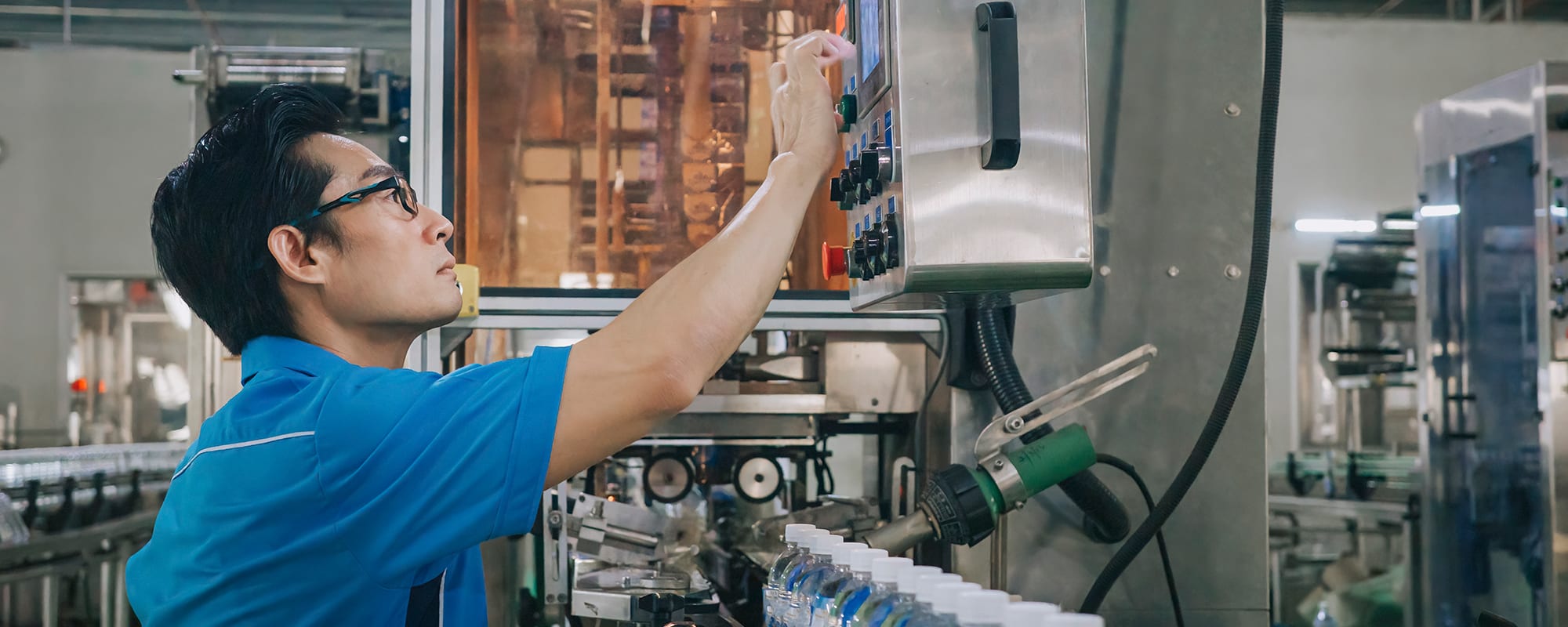Modular machine concepts effectively address two of the many challenges the material handling and packaging industry is currently confronting: improving efficiency and reducing downtime. One of the quickest, easiest, most economical, and most accessible ways to leverage modular machine concepts is to employ devices compatible with IO-Link. This article introduces IO-Link and its many advantages, explains how it can help improve the modularity, efficiency, throughput, and uptime of material handling and packaging machinery, and introduces IO-Link devices from leading suppliers in this industry.
Alicia Keene, Category Marketing Manager, RS
The material handling and packaging industry is currently contending with consumer and market pressures that are driving the need for manufacturers to improve efficiency, reduce equipment downtime, become more sustainable, and comply with evolving regulatory standards. This complex mix of challenges will require numerous solutions. But one solution — modular machine concepts — effectively addresses both efficiency and downtime demands.
Modular machine concepts make it quick and easy to retrofit machines, which allows users to support multiple processes, as well as scale production with the integration of new machines. One of the quickest, easiest, most economical, and most accessible ways to leverage modular machine concepts is to employ devices compatible with the IO-Link communications protocol, which has exploded in popularity since it was standardized in 2006.
The IO-Link communications protocol is an open standard serial communications protocol that uses a simple, fieldbus-agnostic master/device architecture to enable bidirectional data exchange between compatible sensors and devices connected to an IO-Link master. IO-Link masters transmit data over various networks, fieldbuses, and backplane buses to make that data accessible by PLCs and HMIs in real-time, which operators can use to perform both immediate actions and long-term analysis.
IO-Link devices offer multiple advantages valuable to owners and operators in the material handling and packaging industry. They support modularity and interoperability, standardize and reduce device and equipment wiring requirements and costs, acquire and transmit actionable data, enable remote configuration and monitoring, simplify device replacement and equipment retrofits, and provide detailed diagnostics.
Like many elements of the modern manufacturing industry, today’s material handling and packaging processes are increasingly automated. IO-Link devices inform operators about what they’re doing and how well they’re doing it by instantly identifying and communicating any issues. This gives users incredible insight into and control over their sensors, which can improve process efficiency, reduce equipment downtime, increase production, and enable data-driven decision-making. In addition, material handling and packaging equipment often requires frequent changeovers to safely, effectively, and efficiently handle and package a variety of different products. So, the improved efficiency and reduced equipment downtime enabled by IO-Link devices can be a real game-changer.
For these reasons, IO-Link is now the fastest-growing sensor and actuator interface in the world. In 2013, there were less than two million active IO-Link devices. Today, there are over 28 million IO-Link devices, and the IO-Link Consortium, which governs the protocol and ensures device interoperability (that any IO-Link device will work with any IO-Link master), has grown to include more than 400 core user companies and leading global automation suppliers, including Banner Engineering, Phoenix Contact, Norgren, Leuze, SICK, and Siemens. Further, demand is still increasing. IO-Link devices are expected to experience a 20% year-over-year CAGR for the next several years.
The vendor-agnostic interoperability of IO-Link devices enables extensive modularity and is one of the primary reasons behind the technology’s meteoric rise. IO-Link devices are standardized on M12 connectivity. So, while adopters switching from traditional I/O systems with wire-based connections to an IO-Link system standardized on M12 connectivity will have to contend with an upfront investment, IO-Link systems require far less wiring and much quicker and easier to install. As such, the total cost savings enabled by not having to connect every individual sensor, actuator, and other device wire to a PLC, in addition to the cost savings enabled by slashing wiring installation and maintenance times, typically compensates for that initial investment in a short amount of time. In fact, Sean Foley, a Global Product Manager at Banner Engineering, said that he’s seen OEMs achieve 15–20% savings on both hardware and installation costs when going from a standard I/O system to a modular IO-Link system.
RS offers a variety of IO-Link solutions ideally suited for modernizing industrial automation applications in the manufacturing, material handling, and packaging industries by making them more modular.
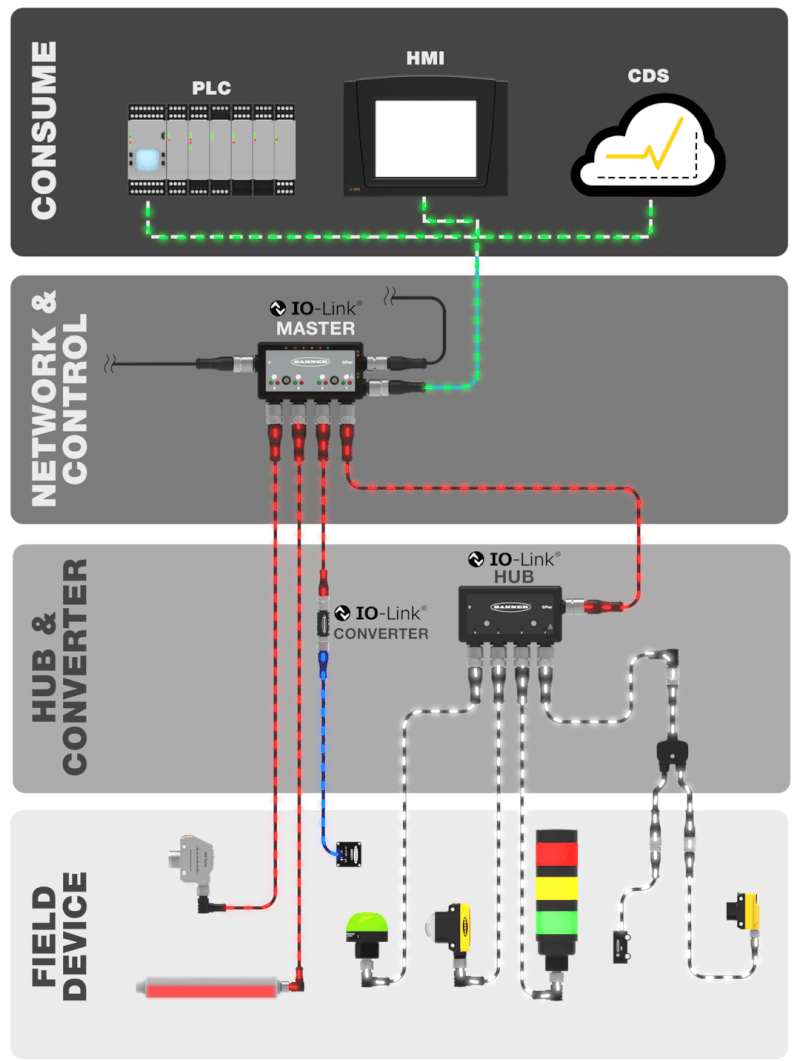
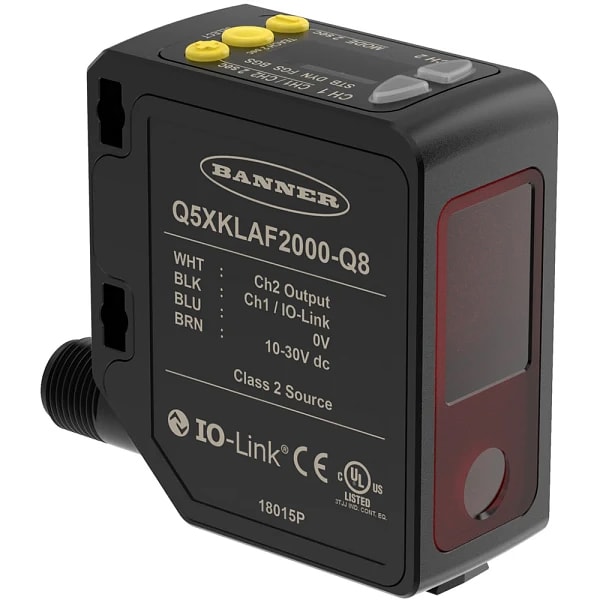
Banner Engineering’s Q5X Series laser measurement sensors have a self-contained, IP67-rated form factor with dual independent output channels and IO-Link capabilities that support plug-and-play modularity. They are also available with an optional remote sensor display (sold separately) that enables remote programming and monitoring.
Banner’s Q5X Series sensors are easy to install, set up, and troubleshoot, which reduces installation costs, They also have bright output indicators for real-time distance feedback, which helps reduce equipment downtime. Unlike traditional measurement sensors, which rely on gaps between packages to identify packaging process jams and are subject to identification delays, the Q5X Series laser sensors have a 5,000mm measurement range and exceptionally high excess gain. This allows them to reliably detect a range of colored objects, including extremely dark targets (e.g., <6% reflective black targets), black targets against black backgrounds, black targets against shiny metal backgrounds, clear and reflective targets, and multicolor targets.
These features enable proactive package jam identification and reduced package spacing for increased throughput. They also reduce false positives, eliminate excessive identification delays, and improve detection accuracy. Ideal material handling and packaging application areas include conveyor power curves, gravity-fed spire conveyors, and non-singulated bulk flow parcel flows. The Q5X Series is also ideal for activities like food pallet presence detection, end-of-line pallet detection, shrink wrap detection, carton full/empty identification, case packing, flexible packaging and pouch filling applications, clear bottle detection, depalletizing, bottle counting and sorting, quality control, filling and capping, and conveyor cleaning.
Supporting products include sensor mounting hardware, protocol converters, M12 cordsets, wire and cable, and M Series connectors.
Phoenix Contact’s Axioline E Series remote I/O system is designed to provide seamless and cost-effective communication between IO-Link sensors and actuators and higher-level control systems. It’s also designed to support future IO-Link updates, ensuring compatibility and longevity for connected systems, and its unique block design enables decentralized automation without a control cabinet.
These robust I/O devices feature rugged diecast zinc housings with IP65 or IP67 ratings, outstanding EMI resistance, an extended operating temperature range, robust mechanics, and strong resistance to environmental influences, common cooling and greasing agents, and welding beads — all of which contribute to minimizing downtime. They also feature tool-free M12 push-pull fast-connection technology with latching connection plugs, which takes 80% less time to cable than M12 screw connectors, saves up to two minutes per device, and provides positive feedback to diminish assembly errors. Additional Axioline E Series features include compatibility with Phoenix Contact’s PLCnext technology automation system, open IIoT architectures, and time-sensitive networking, and built-in security features for field and cloud connectivity.
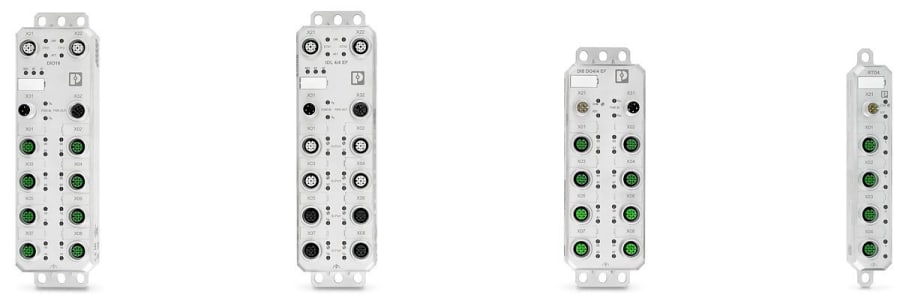
The Axioline E Series provides operators with detailed diagnostic and process data from connected devices and facilitates increased productivity, faster response times, precise control, optimized workflows, predictive maintenance, and improved monitoring and performance. It is widely used in material handling and applications including conveyor systems, sorting and diverting systems, packaging machinery, weight and measurement systems, automated palletizing systems, and robotic systems.
Customers who employ these products may also need Axioline E PLC expansion modules, SAC-4P-M12 cable assemblies, SACC Series connectors, SAC-4PY Y distributors, and SACB-4 sensor junction blocks.
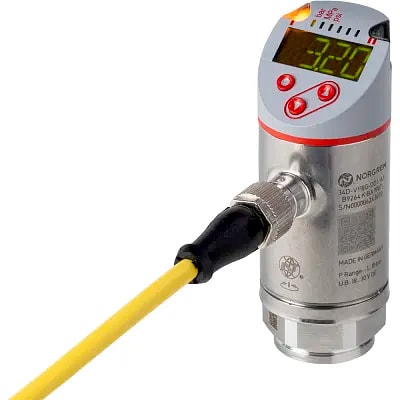
Norgren’s 34D Series electronic pressure sensors are compatible with IO-Link and enable quick installation, simple setup, user-friendly operation, remote access and operation, accurate performance data capture and delivery, and advanced diagnostics for improved efficiency and reliability. They have compact and robust stainless steel form factors engineered for use in harsh-environment applications and angled displays for clear visibility and easy operation. They can handle pressures extending from vacuum to 600 bar and are available in 18 variants equipped with configurable IO-Link connectivity. Related accessories include mounting brackets, adapters, and pre-wired cables designed to support fast and flexible installations in a variety of automated systems.
Norgren’s 34D Series pressure switches are used to automatically measure pressure levels in pneumatic systems, including vacuum packaging and conveyor applications.
They’re also used for more complex monitoring functions in water, hydraulic, and other fluid applications, including beverage product manufacturing and packaging processes, and are essential elements of plant security systems, which can be especially vital in food and beverage material handling and packaging operations. In addition, they can be used in applications that traditional mechanical pressure switches aren’t well suited for, like switching very low voltages in PLCs and other modern electronics that require stability, multiple switch points, and flexible control.
Supporting products include hardware, SC Series cable assemblies, pressure sensors, solenoids, air compressors and pumps, motors, valves, fittings, and wire and cable.
Other modular IO-Link solutions available at RS and ideal for use in material handling and packaging applications include:
- Leuze’s PRK 3C and PRK 18B Series photoelectric sensors, which package transmitters and receivers in the same housing with an opposing reflector, use the reflection principle to reliably detect transparent objects at operating ranges up to 6m and offer integrated tracking for contamination compensation.
- Leuze’s ODSL 8 Series optical distance sensors, which deliver high resolution and accuracy in short-range applications using triangulation measurement, perform well even under difficult sensing conditions (e.g., when sensing glossy objects) and set standards for economical, precise, and user-friendly solutions. They are ideal for use in object measurement and quality control processes and in combination with digital interfaces, which can really reveal their enormous potential for precision.
- Leuze’s ODSL 96K Series optical distance sensors, which leverage propagation time and phase measurement methodologies to deliver accurate distance measurements over long-distance operating ranges up to 65m, feature LED indicators on the top and front to communicate switching status from afar, and are ideal for use in positioning applications. Both measurement methodologies exhibit constant resolution, an extremely small black-white error, and high repeatability and can reliably detect dark, glossy, and colored objects.

- SICK’s AHM36 Series IO-Link enabled absolute encoders, which are equipped with standard M12 male connectors, deliver 12-bit x 12-bit maximum resolution, are rated for 18–30V supply voltages and up to 240 years of operation, and consume ≤1.5W of power. They are often used to provide accurate speed and position information in material handling and packaging applications.
- Siemens’ SIMATIC ET 200AL rugged IO-Link system, which is especially designed for distributed control electronics in confined spaces and on the move, supports quick, easy, and flexible installation, consistent system diagnostics, and efficient operation. Special features include IP65/67 sealing, color-coded sensor and actuator connectors, and secure digital outputs that can be safely shut down within a supply line to support the integration of safety devices while maintaining diagnostic capabilities.
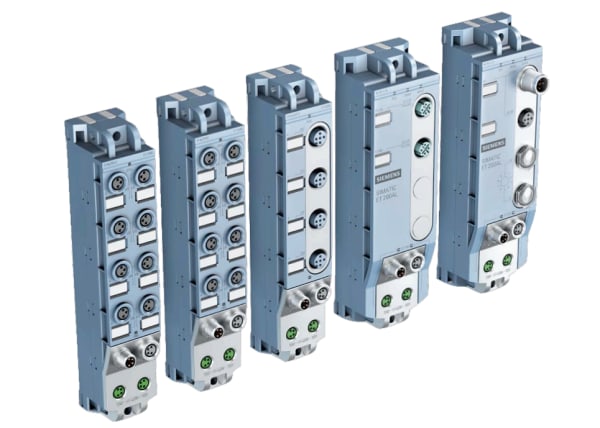
For more information about the RS portfolio of IO-Link devices and other solutions for modernizing your material handling and packaging processes, please visit the links embedded here. For expert insights into and advice about material handling and packaging processes and IO-Link technology, please visit the RS Expert Advice page.
For assistance identifying, procuring, deploying, and maintaining IO-Link solutions that can help you overcome consumer and regulatory pressures and improve the modularity, efficiency, throughput, and uptime of your material handling and packaging equipment, please contact your local RS representative at 1.866.433.5722 or reach out to our technical product support team.
